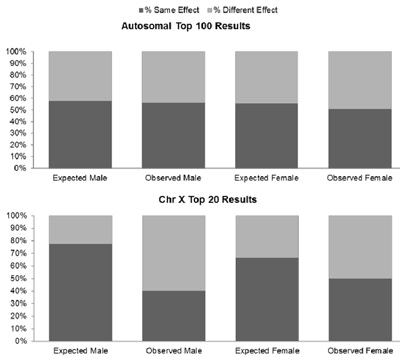
Males are 4.5 times more likely to be affected by autism spectrum disorder (ASD) than females. Recent findings of a higher burden of rare de novo loss-of-function mutations in females have lent support to the “female protective model” for ASD; however, whether such a model also applies to common risk factors for ASD remains to be determined. In the current study, SFARI Investigator Lauren Weiss and colleagues examined single nucleotide polymorphism (SNP) data from numerous ASD datasets, including the Simons Simplex Collection, and evaluated a number of different genetic models that could plausibly generate sex bias. They found no differences between males and females in overall SNP genetic load, in SNPs affecting gene expression levels within the brain or in SNPs affecting levels of sex hormones within these datasets. Their data did, however, support a role for SNP heterogeneity on the X chromosome in contributing to the sex bias observed in ASD. Interestingly, they also found that a substantial number of these SNPs are associated with the regulation of physical differences between the sexes, such as height, weight and waist measurements. These data suggest that genetic mechanisms regulating general differences in sex characteristics — as opposed to brain- or behavior-specific origins for sex differences — contribute to ASD susceptibility. Further, these results reinforce the importance of considering each component of the genetic architecture (e.g., rare variants, common polymorphisms) separately when assessing sex-specific mechanisms in ASD.
Reference(s)
Pleiotropic mechanisms indicated for sex differences in autism.
Mitra I., Tsang K., Ladd-Acosta C., Croen L., Aldinger K.A., Hendren R., Traglia M., Lavillaureix A., Zaitlen N., Oldham M.C., Levitt P., Nelson S., Amaral D., Herz-Picciotto I., Fallin M.D., Weiss L.


